Eltanin, Gamma Draconis (γ Dra), is an orange giant star located in the constellation Draco. With an apparent magnitude of 2.23, it is the brightest star in Draco. It lies at an approximate distance of 154.3 light years from Earth. Eltanin and its neighbour Rastaban (Beta Draconis) mark the eyes of the celestial Dragon.
Star type
Eltanin has the stellar classification K5 III, indicating a giant star appearing orange in colour. The star has a mass 1.72 times that of the Sun and, as it evolved away from the main sequence, it has expanded to a size of 48.15 solar radii. With a surface temperature of 3,930 K, it is about 471 times more luminous than the Sun. Eltanin is a slow spinner, with a projected rotational velocity of 6 km/s. The star is not massive enough to meet its end as a supernova. Instead, when it reaches the end of its life cycle, it will cast off its outer layers to form a planetary nebula and slowly fade away as a faint white dwarf.
Various double star catalogues list six companions for Eltanin, all discovered by the American astronomer Sherburne Wesley Burnham, who published his A General Catalogue of Double Stars within 121° of the North Pole in 1906. The nearest of the six stars, a red dwarf, may be a physical companion separated from Eltanin by about 1,000 astronomical units. The other five stars are visual companions located at greater distances and not physically related to Eltanin.
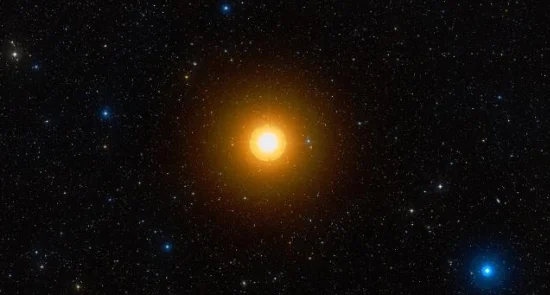
Eltanin (Gamma Draconis), image: Wikisky
Facts
Eltanin is one of the four relatively bright stars that outline the head of Draco, the Dragon. The other three stars are Rastaban (Beta Draconis), Grumium (Xi Draconis) and Nu Draconis (traditionally but not formally known as Kuma).
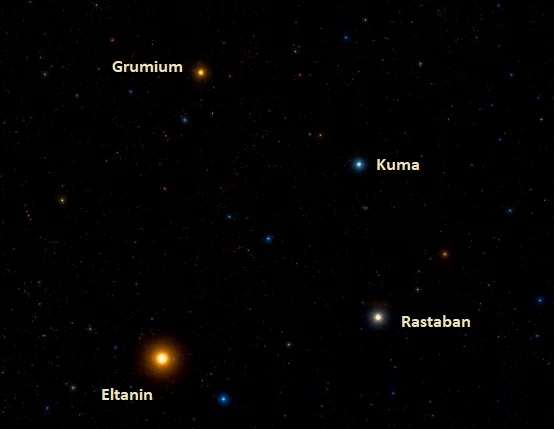
The Head of Draco, image: Wikisky
Eltanin is one of the 58 bright stars that have a special status in the field of celestial navigation. It is the only navigational star in Draco and one of 11 northern navigational stars with a declination between 30° N and 90° N. Other stars in this group include Deneb in Cygnus, Capella in Auriga, Mirfak in Perseus, Schedar in Cassiopeia, Vega in Lyra, Polaris and Kochab in Ursa Minor, and Alioth, Alkaid and Dubhe in Ursa Major.
Eltanin has been used as a spectral standard for its class since 1943. Its spectrum serves as one of the stable anchor points for the Morgan-Keenan system of spectral classification, used to classify other stars.
If its luminosity does not change, Eltanin will be the brightest star in the Earth’s sky in about 1,330,000 years, taking over from the variable giant Delta Scuti. Eltanin will reach a peak magnitude of -1.39 (which is slightly fainter than Sirius is today) in 1,550,000 years, when it comes within 27.7 light years of the solar system. It will be succeeded as the brightest star by the orange giant Upsilon Librae in about 2,030,000 years.
Eltanin played a key role in confirming Copernicus’ theory that the Earth revolves around the Sun. In 1728, the English astronomer James Bradley attempted to measure the star’s parallax and, while he was not successful in his attempt, he did discover the aberration of light, caused by the velocity of the Earth’s motion relative to the speed of the light coming from the star. Bradley’s discovery confirmed that what Copernicus had been saying a couple of centuries earlier was right.
Like other bright stars, Eltanin has often been used or referenced in works of fiction. Notable uses include the novels Planet of Exile (1966) by Ursula K. Le Guin and The Last Castle (1966) by Jack Vance. The star is also used in the strategy game Master of Orion II and computer game FreeSpace 2.
Name
The name Eltanin (pronunciation: /ɛlˈteɪnɪn/) comes from the Arabic At-Tinnin, meaning “the great serpent.” It was mentioned in the 15th century Timurid astronomer Ulugh Beg’s star catalogue as Al Ras al Tinnin, meaning “the dragon’s head.” The name has also been spelled Ras Eltanim, Etamin, Etannin, and Etanim.
The name was approved by the International Astronomical Union’s (IAU) Working Group on Star Names (WGSN) on August 21, 2016.
Gamma Draconis was also once known as Rastaban, derived from the Arabic ra’s ath-thu’ban, meaning “the head of the serpent/dragon.” The 17th century German astronomer Johann Bayer, who assigned Greek letter designations to stars, called it Rastaben and, in the Alphonsine Tables, it was called Rasaben. Today, the name Rastaban applies to the neighbouring Beta Draconis, the other eye of the Dragon.
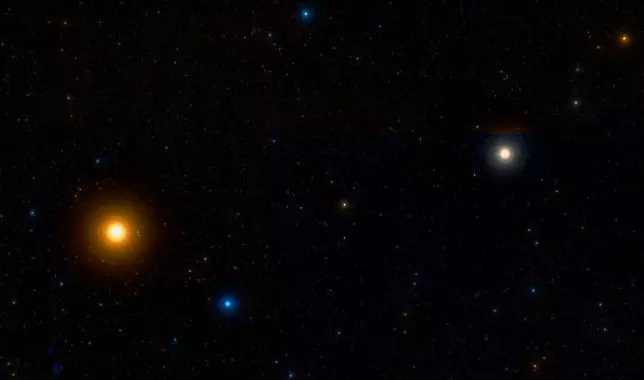
Eltanin and Rastaban, image: Wikisky
In Arabic astronomy, Eltanin was known as one of the Mother Camels (Al ʽAwāïd). The name was later translated into Latin as Quinque Dromedarii. The other Mother Camels were Rastaban (Beta Draconis), Alrakis (Mu Draconis), Nu Draconis, and Grumium (Xi Draconis). The asterism represented four camels protecting a baby camel from two hyenas.
In the British Isles, Eltanin was known as the zenith star, as it lies almost exactly in the zenith when observed from Greenwich.
The Chinese know Eltanin as 天棓四 (Tiān Bàng sì), meaning the Fourth Star of Celestial Flail. The Chinese Celestial Flail asterism is formed by Eltanin with Rastaban (Beta Draconis), Nu2 Draconis, Grumium (Xi Draconis), and Iota Herculis. It is part of the Purple Forbidden Enclosure mansion, which represents the imperial palace in Chinese astronomy.
Location
Eltanin is relatively easy to find on a clear night because it is part of an asterism that represents the head of the Dragon, and lies just north-northwest of the bright Vega. The star and the Dragon’s head asterism can be seen in the vicinity of the larger and more prominent Northern Cross, formed by the bright Cygnus stars Deneb, Sadr, Albireo, Aljanah and Fawaris. Eltanin can be found by extending an imaginary line from Sadr, the central star of the Northern Cross, through Fawaris, the star that marks one of the Swan’s wings. Both Eltanin and Rastaban lie on this imaginary line.

The location of Eltanin and Rastaban, image: Wikisky
Eltanin can be used to find the faint spiral galaxy NGC 6478, which lies in the same field of view as the star.
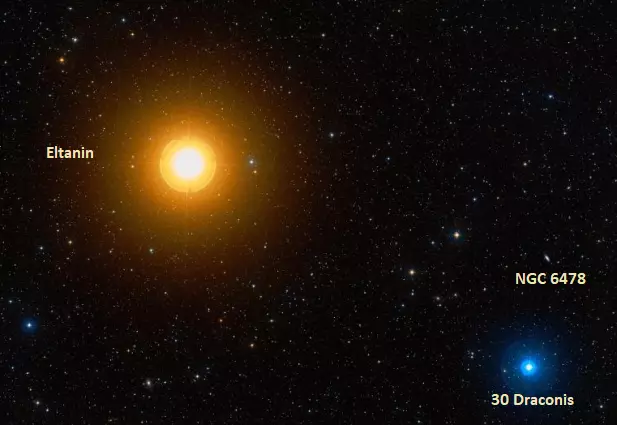
Eltanin and NGC 6478, image: Wikisky
Constellation
Eltanin is located in the constellation Draco and marks the right eye of the celestial dragon. Representing the dragon that guarded the golden apples in the gardens of the Hesperides in Greek mythology, Draco is one of the 48 Greek constellations, first listed by the Greek astronomer Claudius Ptolemy in the 2nd century CE.
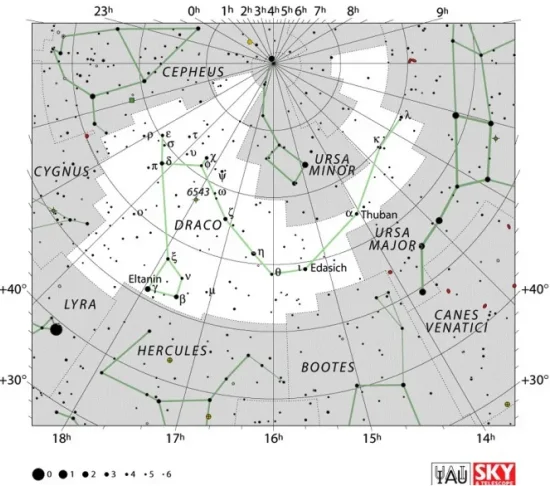
Draco constellation map by IAU and Sky&Telescope magazine
Draco is one of the larger constellations, stretching across 1,083 square degrees of the northern sky around Polaris and Ursa Minor. It is the fourth largest northern constellation and eighth largest of all 88 constellations. For northern observers, Draco is circumpolar, i.e. it never sets and can be seen throughout the year.
Draco contains several notable deep sky objects. These include the Spindle Galaxy (NGC 5866), a bright lenticular galaxy believed to be the object Charles Messier catalogued as Messier 102, the Tadpole Galaxy (Arp 188), a disrupted spiral galaxy with a massive trail of stars produced by a merger with a smaller galaxy, the Draco Dwarf Galaxy, a faint satellite of the Milky Way, the Cat’s Eye Nebula (NGC 6543), a magnitude 9.8 planetary nebula located about 3,300 light years away, and Abell 2218, a massive galaxy cluster containing about 10,000 members, located about 2 billion light years from Earth.
The best time of year to observe the stars and deep sky objects of Draco is during the month of July, when the constellation rises high in the evening sky.
The 10 brightest stars in Draco are Eltanin (Gamma Dra, mag. 2.23), Athebyne (Eta Dra, mag. 2.73), Rastaban (Beta Dra, mag. 2.79), Altais (Delta Dra, mag. 3.07), Aldhibah (Zeta Dra, mag. 3.17), Edasich (Iota Dra, mag. 3.29), Chi Draconis (mag. 3.57), Thuban (Alpha Dra, mag. 3.6452), Grumium (Xi Dra, mag. 3.75), and Giausar (Lambda Dra, mag. 3.85).
Eltanin – Gamma Draconis
| Spectral class | K5 III |
| U-B colour index | +1.87 |
| B-V colour index | +1.53 |
| Apparent magnitude | 2.23 |
| Absolute magnitude | −1.93 ± 0.07 |
| Distance | 154.3 ± 0.7 light years (47.3 ± 0.2 parsecs) |
| Parallax | 21.14 ± 0.10 mas |
| Radial velocity | –28.19 ± 0.36 km/s |
| Proper motion | RA: –8.48 ± 0.11 mas/yr |
| Dec.: –22.79 ± 0.10 mas/yr | |
| Mass | 1.72 M☉ |
| Luminosity | 471 ± 30 L☉ |
| Radius | 48.15 ± 1.09 R☉ |
| Temperature | 3,930 K |
| Metallicity | -0.14 dex |
| Rotational velocity | 6.0 km/s |
| Surface gravity | 1.55 cgs |
| Constellation | Draco |
| Right ascension | 17h 56m 36.36988s |
| Declination | +51° 29′ 20.0242″ |
| Names and designations | Eltanin, Etanin, Rastaban, Rasaben, Zenith Star, Gamma Draconis, γ Dra, 33 Draconis, HD 164058, HR 6705, HIP 87833, BD +51°2282, FK5 676, SAO 30653, GC 24432, GCRV 10394, PPM 36267, JP11 2911, IRAS 17554+5129, PLX 4107, 2MASS J17563637+5129197, N30 3992, UBV 15288, TYC 3523-1684-1, ADS 10923 A, CCDM J17566+5129A, WDS J17566+5129A |